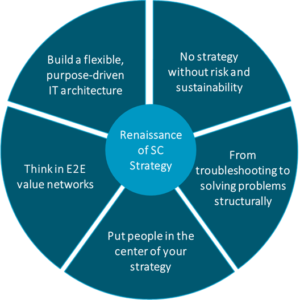Many companies have realized that successful supply chains make a difference while competing for market share and increasing profitability. This puts their supply chains on top of their management agenda. In this context, defining the right supply chain strategy not only becomes pivotal for company success, but also the bar for leading supply chain strategy is rising. To remain competitive, supply chain needs to address many new dimensions of success, e.g., people, sustainability, risk, and operating in cross-organizational ecosystems.
Over the last decade, the importance of supply chain management has increased significantly, long before everyone has been able to observe the impact of damaged or disrupted global supply chains in real-time, be it due to global trade wars, natural disasters, or COVID-19. By now we see that a successful supply chain gives companies an edge in the market and helps to increase profitability. With that comes the management attention needed to tackle further challenges.
Three Big Challenges for SCM
Now, at times in which many companies have developed strategic roadmaps for supply chain excellence, three trends challenge the very foundation of supply chains, requiring a fundamental rethinking of SC strategy:
Accelerating uncertainty and non-linearity
Today’s supply chains are complex networks, typically on a global scale, and characterized by a vast set of interdependencies to internal as well as external influencing factors. These networks are vulnerable to single (sometimes rather small) events that can quickly turn into a serious threat and have a massive impact on the performance of entire value chains. Increasing market volatility, critical material shortages and dramatically increasing raw material prices, as well as accelerating frequency of disruption events are just a few examples describing the New Now, supply chains find themselves in today.
Exponential technological development
In addition to that, the technological development has taken a breathtaking acceleration over the past years, with new opportunities from technologies like in-memory databases and massively increased computation power, over Machine Learning, Artificial Intelligence, and Robotic Process Automation, to hyper automation and digital supply chain twins. With an exponentially increasing number of use cases in supply chain management, everything seems to be possible on the way towards fully self-driving, fully automated supply chains. But technology alone is not a silver bullet. It needs to be integrated with the required skills and applied by the right people to make it work, and companies need to find use cases where it delivers actual value.
Labor and Talent Shortage
Both trends are massively affecting the internal workings of supply chains – and with that further intensifying the third big challenge for modern supply chains: supply chain labor and talent shortage.
Traditional roles in supply chain management are changing significantly and completely new job descriptions are arising which bring totally different requirements for supply chain personnel. There is an increasing need for qualified professionals who combine an understanding of the business dynamics, supply chain methodologies, and technology potentials – and with that, the true bottlenecks of future supply chains are the required skills and people to successfully operate in this New Now.
Need to Fundamentally Rethink Supply Chain Strategy
To cope with this new reality in supply chain management, we need to not only update, but also fundamentally rethink classical supply chain strategies. We see five key principles that need to be considered for any future supply chain strategy:

1. No Strategy without Risk and Sustainability
Traditionally, supply chain management has been pretty much about balancing service, cost, and capital. Answering businesses’ service requirements at lowest cost and with optimized capital investments has been the key paradigm of any supply chain. But these three dimensions alone fall short to adequately cover the requirements modern supply chains need to cover. Supply chains cannot be successful without considering risk and sustainability, neither in the eyes of customers, nor employees, nor stakeholders. Integrating these two additional dimensions into the supply chain target function has implications on all levels of supply chain strategy: from supply chain network design, over core tactical processes (e.g., risk-aware planning, energy-efficient fleet and transport planning), to operations (for instance including sustainability effects in operational excellence). Risk and sustainability not only need to be integrated in the core supply chain metrics and targets, but also practically embedded in work routines, decision rules, and capability building.
2. From Troubleshooting to Structural Problem Solving
For a long time, the focus of many companies has been on troubleshooting within the supply chain (e.g., bottleneck management, quick inventory reductions), mainly driven by the need to fulfill demand and push performance in the short term. Others have sought to improve supply chain performance by mainly focusing on new software systems and technology. Now, more and more companies come to realize that at the core to reaching a new level of supply chain performance is addressing structural weaknesses, starting with processes and people. This means designing and implementing improved core supply chain processes and supporting them optimally with tailored operating models (responsibilities, organization, metrics, incentives). In more detail, that is for example:
- Standardize processes as much as possible and avoid unnecessary variants.
- Create robust, rule-based processes which enable exception-based management.
- Focus the core supply chain team on critical, value-adding activities.
- Improve handovers between functions and remove redundancies.
- Introduce decision automation, starting with structured, repetitive tasks.
- Measure outcomes and process quality with the right KPI and process health indicators.
3. Put People in the Center of Your Strategy
Qualified personnel will be the key limiting factor for future supply chains. This makes attracting and retaining required supply chain talent as well as upskilling the existing workforce one of the biggest challenges of our time. Therefore, modern supply chains need to be built around people, treating the human capital as the most critical asset.
As traditional roles significantly change (for instance in terms of scope, speed of decision making, and ability to effectively work with modern technology) and completely new job profiles (e.g., data scientists) arise, traditional ways of working and collaboration approaches also need to change.
Key to success in the war for supply chain talent is to create purpose-driven, agile work structures that are better at supporting business needs as well as responding to personal needs, e.g.:
- Linking personal incentives with overall success towards the customer.
- Overcoming static hierarchy and moving towards flexible, task-oriented team structures.
- Building trust by empowering people to deliver agreed outcomes (no micro-management!).
- Offering flexible, cross-functional development options instead of pre-defined, linear career paths.
- Creating a human-centric work environment to best support employees executing their jobs.
4. Think in E2E Value Networks
Thinking in value networks beyond individual company boundaries is key to success. But the prerequisite for that is transparent information exchange, shared goals, and joint (holistic) optimization with partners along the value chain.
Creating transparency across company boundaries means for instance understanding the actual E2E cost-to-serve and delivery-and-order status as well as mutually focusing on end-customer service levels instead of just looking up to the next stage in the supply chain. Based on this transparency, decision making needs to be aligned between partners as well to achieve common goals. Joint planning approaches, for instance enabled by cross-company S&OP decision platforms, help to better direct efforts fulfilling end-customer requirements effectively and efficiently. But also joint operative task forces are an important element to quickly resolve immediate problems within the end-to-end supply chain, for instance in making mutual prioritization decisions in case of backlog situations.
The ultimate goal needs to be enlarging the cake instead of fighting over crumbs: Creating the overall value network optimum is more favorable for all partners along the value chain instead of just optimizing the silo at home.
5. Build a Flexible, Purpose-Driven IT Architecture
Lastly, we need to create an IT architecture that enables improvements driven by the process and operating model in an optimal way. For that, it’s required to leave old architecture paradigms with monolithic, on-premise supply chain planning and execution systems behind. Traditional supply chain software, for instance, struggles to provide fast simulation capabilities and implementable decisions at the same time due to factors like non-integrated data models, static granularity (time buckets vs. order focus), and lack of supply chain integration capabilities.
Therefore, we need to move to an architecture that overcomes these shortcomings by seamlessly integrating simulation and planning capabilities across supply chain stages as well as integrating planning and execution levels to enable a direct implementation of simulation results. With soaring amounts of data to be processed and the simultaneous need of quick decision support and execution, modern supply chain systems also need sufficient computation power to provide results in near real-time.
We see four key elements for modern supply chain IT architectures to achieve superior run-time while providing the abovementioned multi-dimensional integration:
- Cloud-native design that enables flexible scalability and the integration of supply chain partners, organized in a supply chain planning mesh.
- Parallelization and decomposition of procedures to efficiently use computation power.
- Flexible data models to enable ultra-fast data access by always using the right level of aggregation for data analyses.
- Integration of various analytical algorithms to deliver the best problem-specific cost/benefit ratio in terms of calculation time and solution precision.
Adapt or Die
We see ourselves confronted with supply chain challenges never faced before, and there is no indication that this change will reverse. Thus, the current transformations that are shaking the foundation of supply chain management as we knew it, will also not be the last adaption supply chains will need to undergo. In fact, we can expect that adaptation cycles will accelerate and with that supply chain strategies will need to adapt as well. Embracing change and proactively rethinking supply chain strategies along the five principles described above is therefore a critical prerequisite to remain competitive and to survive in today’s turbulent times: adapt or die!

